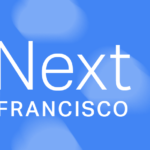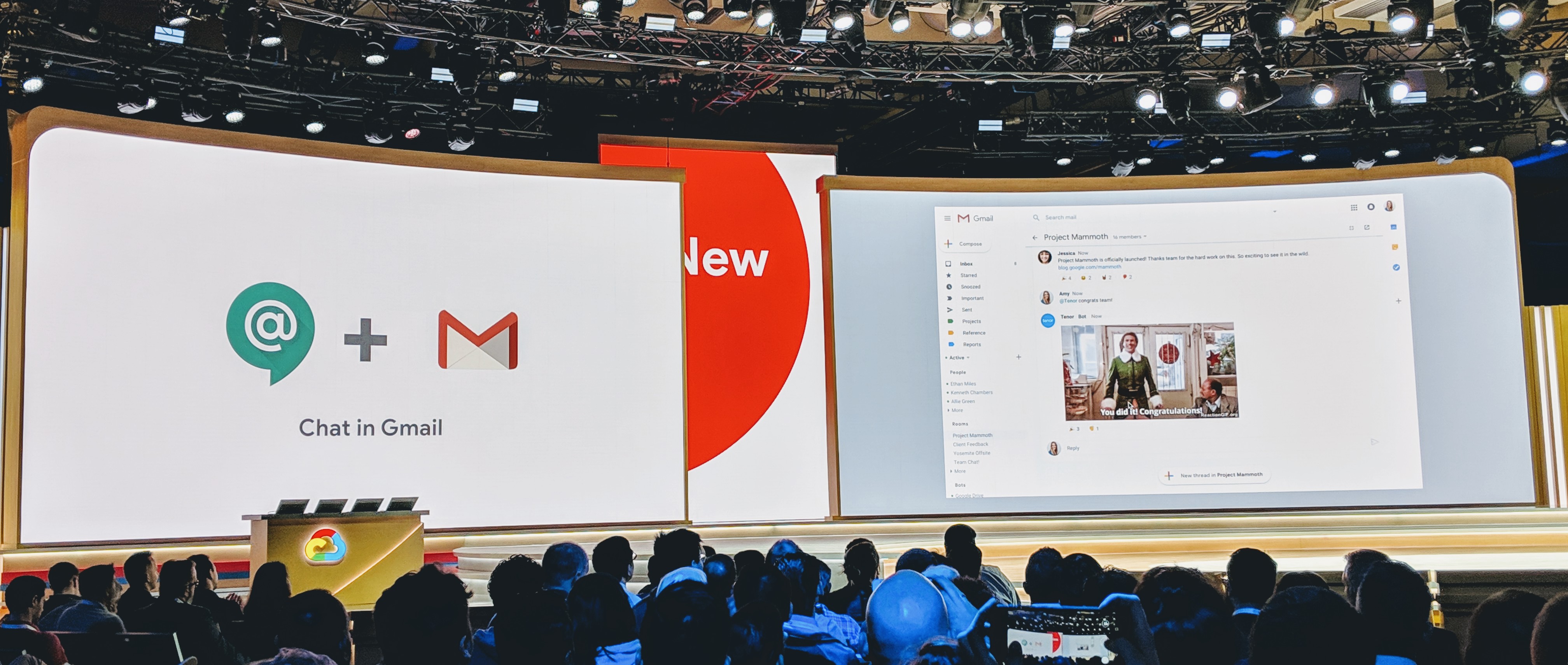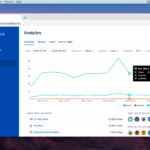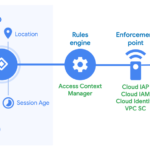What’s left of Google+ is now called Currents
Google+ for consumers is officially dead, but it’s still alive for enterprise users. Only a few days after completely shutting down the public version of Google+, Google today announced that it is giving the enterprise version a new name. It’s now called Currents.
If that name sounds familiar, it’s because Google once offered another service called Currents, a social magazine app with Google+ integrations that was later replaced by Google Play Newsstand. That history clearly bodes well for the new Currents.
Like before, Google+/Currents is meant to give employees a place to share knowledge and provide them with a place for internal discussions.
Google is probably doing the right thing by completely eliminating the Google+ moniker. The fact that there was still a version of Google+ for the enterprise created a bit of confusion when it announced the shutdown of the consumer version. Maybe this move will also allow the remaining developers on the project to leave the failed legacy of Google+ behind and try something new. As the only focus is now on business users, that should be fairly easy, even though the code base surely still reflects a time when Google’s leadership thought that social search was the future.
Powered by WPeMatico
Hangouts Chat is coming to Gmail for G Suite users
The least said about Google’s messaging strategy, the better. But for better or worse, Hangouts Chat and Meet for G Suite, Google’s work-focused text and video chat tools, are here to stay, given that the one area where Google’s messaging strategy is clear is in the enterprise. With the end of the old Hangouts experience drawing nearer, the company today announced it is now essentially replacing classic Hangouts with its business-focused Hangouts Chat tool in Gmail.
That’s a pretty sensible move, and doesn’t come as a major surprise, but this marks the first time that Google has clearly laid out its strategy for how it will replace Hangouts in Gmail for its business users.
The experience, as far as we can tell, will be very similar to the current Hangouts. Unsurprisingly, Hangouts Meet in Gmail will not just feature people, but also rooms and bots, two of the key differentiators between the old and new Hangouts. One difference worth mentioning, though, is that rooms will open into a full-screen experience with threads, which will make for a slightly different experience compared to what you’re probably used to from the classic Hangouts.
For now, this new feature isn’t quite ready to launch yet. Google is asking businesses that want to participate in the beta to register their interest here.
Powered by WPeMatico
Google Cloud unveils new identity tools based on Zero Trust framework
Google Cloud announced some new identity tools today at Google Cloud Next designed to simplify identity Access Management within the context of the BeyondCorp Zero Trust security model.
Zero Trust, as the name implies, means you have to assume you can’t trust anyone using your network. In the days before the cloud, you could set up a firewall and with some reasonable degree of certainty assume people inside had permission to be there. The cloud changed that, and Zero Trust was born to help provide a more modern security posture that took that into account.
The company wants to make it easier for developers to build identity into applications without a lot of heavy lifting. It sees identity as more than a way to access applications, but as an integral part of the security layer, especially in the context of the BeyondCorp approach. If you know who the person is, and can understand the context of how they are interacting with you, that can give strong clues as to whether the person is who they actually say they are.
This is about more than protecting your applications, it’s about making sure that your entire system from your virtual machine to your APIs are all similarly protected. “Over the past few months, we added context-aware access capabilities in Beta to Cloud Identity-Aware Proxy (IAP) and VPC Service Controls to help protect web apps, VMs and Google Cloud Platform (GCP) APIs. Today, we are making these capabilities generally available in Cloud IAP, as well as extending them in Beta to Cloud Identity to help you protect access to G Suite apps,” the company wrote in an introductory blog post.

Diagram: Google
This context-aware access layer protects all of these areas across the cloud. “Context-aware access allows you to define and enforce granular access to apps and infrastructure based on a user’s identity and the context of their request. This can help increase your organization’s security posture while giving users an easy way to more securely access apps or infrastructure resources, from virtually any device, anywhere,” the company wrote.
The G Suite protection is in beta, but the rest is generally available starting today.
Powered by WPeMatico
Atlassian gives Confluence a makeover, acquires Good Software
Atlassian today announced a new version of Confluence, its collaboration platform. While the company has recently focused more on tools like Jira, Bitbucket and Trello, Confluence has continued to gain traction as a content collaboration tool for technical and non-technical teams. Indeed, even though it’s been quiet around it, it’s the second-most revenue-generating product for Atlassian right now. With this release, Atlassian is once again putting the spotlight on Confluence.
To do this, Atlassian also today announced that it has acquired Good Software, a company that makes analytics tools for Confluence users and admins.
In total, Atlassian is announcing 15 new features for the product. Unsurprisingly, given the acquisition of Good Software, one of these new features is extended analytics. With this, Confluence users will be able to see how others in their company engage with their content. The idea here, Atlassian says, is to help everybody write better content and not just see who writes the most popular copy (though that’s surely how this will also be used). There are some other uses here, too, though. An HR manager may notice that a page with outdated information is still getting hits, for example.
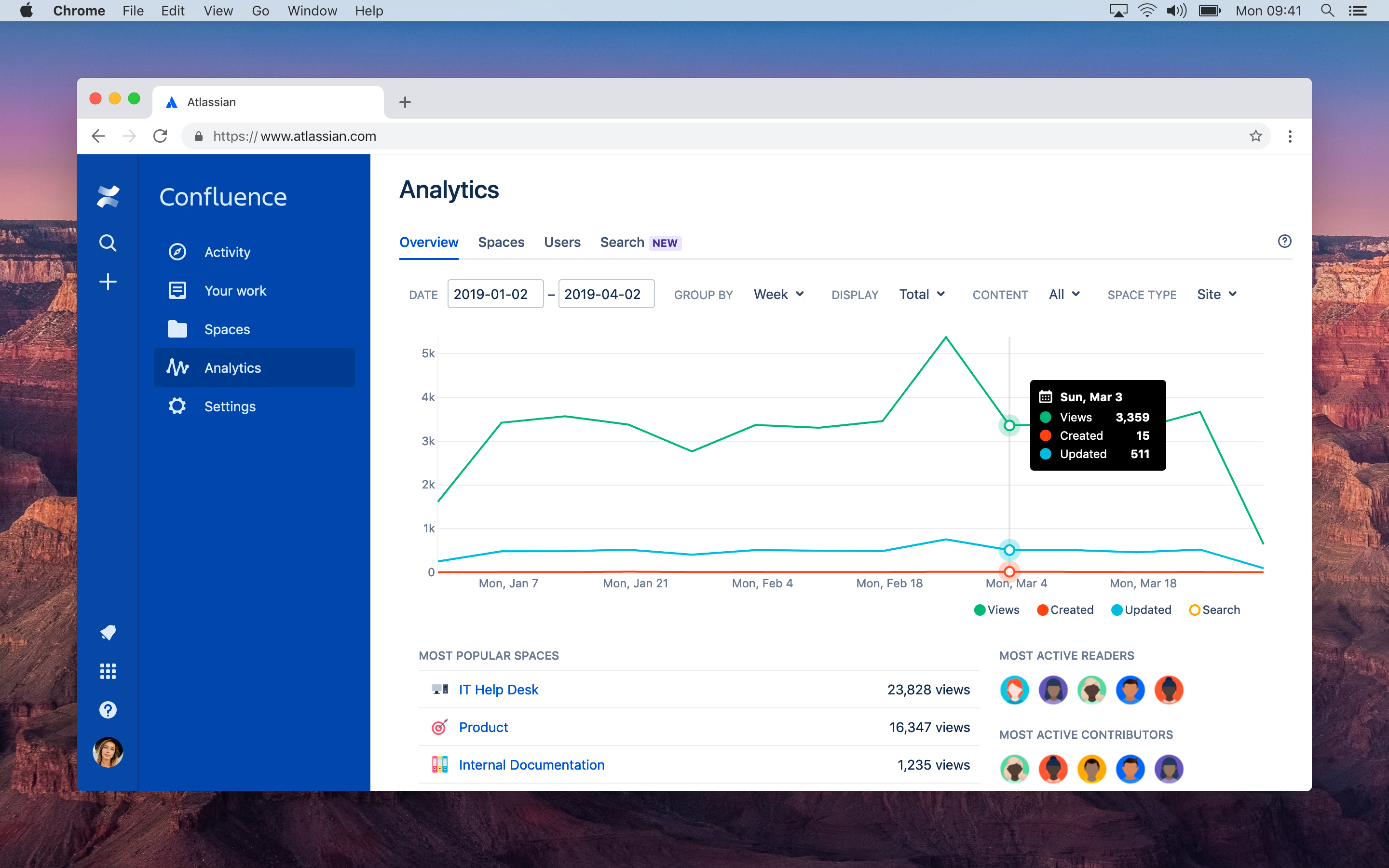
Over time, Atlassian will integrate these features more deeply into the rest of Confluence.
Another major new feature is the introduction of an updated editor. The core features of this new editor are actually shared across most Atlassian products now, but as Pratima Arora, the company’s head of Confluence, told me, that editor is then tweaked for the individual products. For Confluence, this means support for the ever-important feature of adding emojis to your pages, but at the core of that is the new slash (/) command that, similar to Slack, lets you add tables, images and macros to your pages. Other new features include the ability to easily create better-looking tables of content, action items, roadmaps and due dates, as well as smartlinks that automatically preview content for services like Google Drive, Dropbox, Trello, GitHub and others. All of this is meant to make organizing content just a little bit easier.
Also new are a set of new templates and a new media experience.
“Once a niche wiki and documentation tool for developers, Confluence has become a universal content collaboration tool that’s easily used by any team, technical or non-technical,” Arora writes in today’s announcement. “In fact, one in four Confluence Cloud customers use it throughout their entire company, according to recent customer data.”
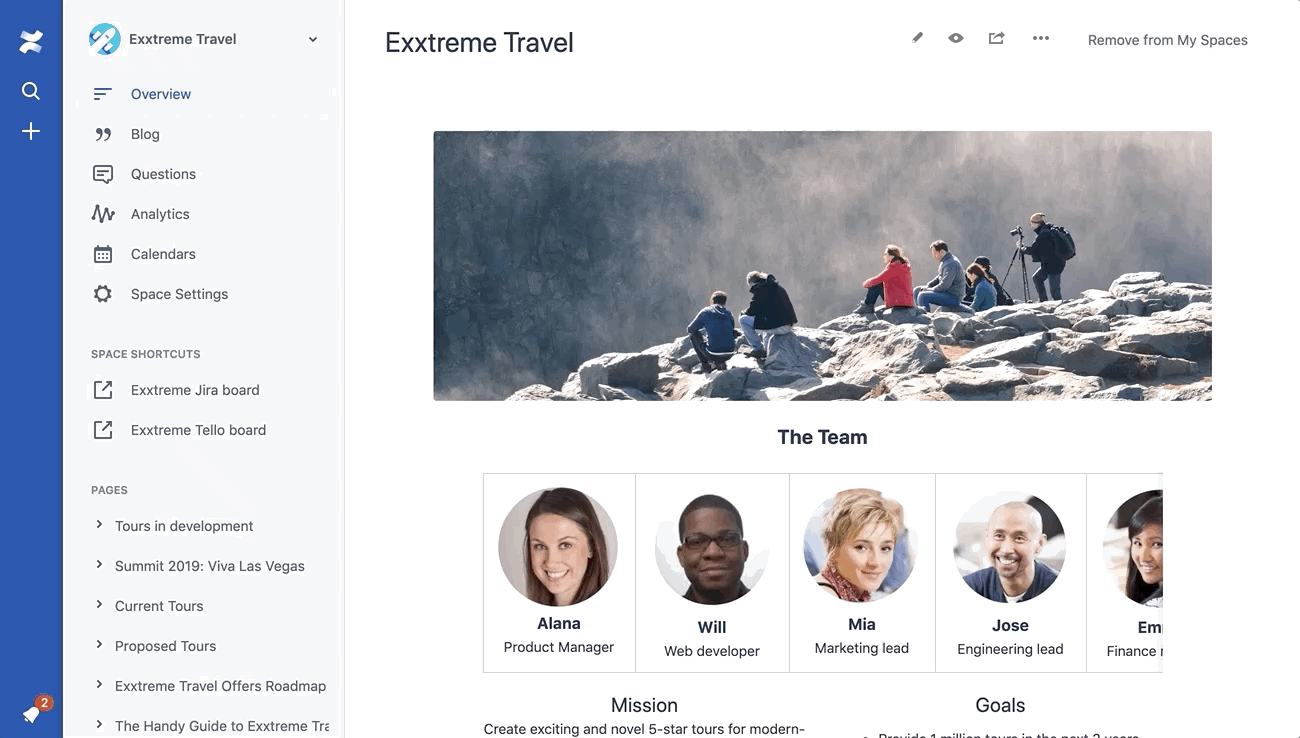
Powered by WPeMatico
Google extends its BeyondCorp security model to G Suite
BeyondCorp is Google’s model for securing networks not just through VPNs and other endpoint security techniques, but through a model that focuses on context-aware access policies that focus on the user’s identity, hardware and the context of the request. That has been Google’s internal security policy for a while now and over the last few months, it started bringing it to its own customers, too, starting with its Cloud Identity-Aware Proxy, which is now generally available, and its VPC Service Controls.
Today, the company is extending these context-aware access capabilities to its Cloud Identity user and device management service, as well as G Suite, its productivity suite. So while earlier implementation centered around protecting a company’s technical cloud infrastructure, this release focuses on devices and cloud-based apps like Gmail, Drive, Docs, Sheets and Calendar.
In this context, some devices, for example, may be more highly trusted because they have been enrolled in the Cloud Identity service and because a number of security policies are in place for it. That’s a different kind of security posture than a system that simply trusts users because they come through a specific VPN.
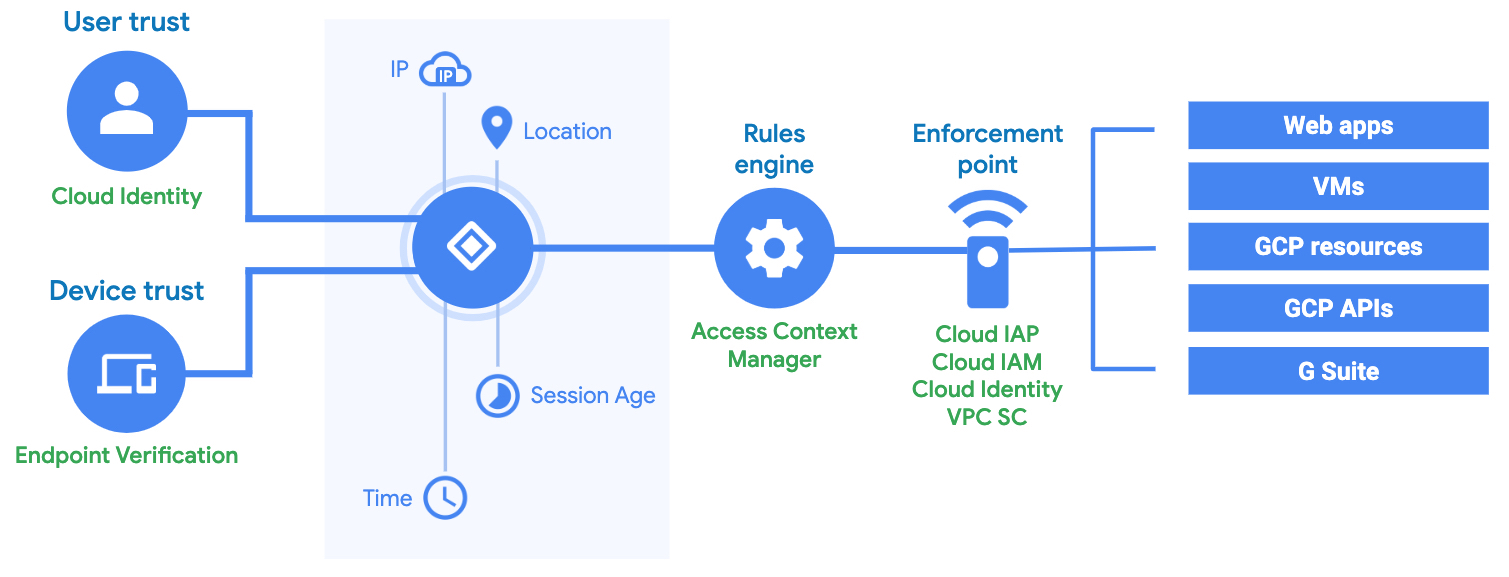
Context-aware access for G Suite apps is now in beta, but only for customers who subscribe to Cloud Identity Premium, G Suite Enterprise and G Suite Enterprise for Education.
With today’s release, Google also announced the BeyondCorp Alliance, which brings together a number of security and management partners. These include Check Point, Lookout, Palo Alto Networks, Symantec and VMware. According to Google, these companies are all working to bring device posture data to Google’s context-aware access engine.
Powered by WPeMatico
Oppo’s new flagship has a bit of everything
It shares a name with the biggest little city in the world, and, fittingly, the Oppo Reno appears to have a lot going for it. Top level, there’s a nutty pop-up camera wedge for selfies, 10x zoom, a 48-megapixel camera, in-display fingerprint reader and an optional 5G version. It’s got a whole lot of everything.
The handset makes its debut in Zurich today, but the company offered up just about all of the insight you’ll need earlier this morning. There are going to be a few different versions of the handset, including the 6.4-inch standard and the 6.6-inch version, which sports the aforementioned 10x Zoom, along with a Snapdragon 855.
We are excited to announce #OPPOReno will be one of the first commercially available 5G phones to hit the European market, and we are proud to partner with @Swisscom to achieve this milestone through our 5G Landing Project! #FirstTo5 #GetReadyForReno pic.twitter.com/WAglcDGnVF
— OPPO (@oppo) April 10, 2019
More info on the 5G version is still forthcoming, but Oppo says it will be “one of the first commercially available 5G phones to hit the European market,” using Swisscom’s network. On that note, I would be surprised to see the handset available in the States, as Oppo doesn’t have much of a footprint in this part of the world. More info on availability in places like Europe and India is coming later this month.
As for pricing, the base-level model starts at around $450, with the zoom starting at around $600. Pricing on the non-5G versions go up to just over $700.
Powered by WPeMatico
Esports org OverActive Media gets investment from The Weeknd
OverActive Media, the company that owns the Splyce esports org and the Overwatch League’s Toronto Defiant team, have announced that The Weeknd (real name: Abel Tesfaye) has invested in the company.
In the world of esports, OAM is a big organization — the Toronto-based company, which launched in 2017, has teams in the League of Legends European Championship, Overwatch League, Call of Duty World League, Rocket League, Starcraft and Smite. OAM is one of only five esports orgs in the world with permanent slots both in League of Legends and the Overwatch League.
If you have no idea what I’m talking about, here’s a look at one of the Toronto Defiant’s recent Overwatch League games.
The terms of the investment were not disclosed, but it would appear that The Weeknd will be contributing to some marketing efforts and building brand awareness around Splyce and the Toronto Defiant.
“Abel’s standing in the music industry will provide our Toronto Defiant and Splyce brands the opportunity to reach more fans and engage new audiences,” said OAM CEO and president Chris Overholt.
The release also mentions that Toronto Defiant fans will see “unique joint efforts” with The Weeknd throughout the 2019 Overwatch League seasons.
Here’s what The Weeknd had to say, via the release:
As a big esports fan, I am really excited to be involved in this project. I am looking forward to collaborating with OverActive Media in unique and innovative ways.
The Weeknd is not the first musical artist to invest in an esports org. Drake and Scooter Braun invested in esports company 100 Thieves in October of 2018.
Powered by WPeMatico
CleverTap lands $26M for its mobile-focused customer marketing service
CleverTap, an India-based startup that lets companies track and improve engagement with users across the web, has pulled in $26 million in new funding thanks to a round led by Sequoia India.
Existing investor Accel and new backer Tiger Global also took part in the deal, which values CleverTap at $150-$160 million, the startup disclosed. The deal takes CleverTap to around $40 million from investors to date.
Founded in 2015 and based in Mumbai, CleverTap competes with a range of customer experience services, including Oracle Cloud. Its service covers a range of touchpoints with consumers, including email, in-app activity, push notifications, Facebook, WhatsApp (for business) and Viber. Its service helps companies map out how their users are engaging across those vectors, and develop “re-engagement” programs to help reactive dormant users or increase engagement among others.
The company says its SDK is installed in more than 8,000 apps and its customers include Southeast Asia-based startups Go-Jek and Zilingo, Hotstar in India and U.S.-based Fandango . With a considerable customer base in Asia, CleverTap puts a particular focus on mobile because many of these markets are all about personal devices.
“Asia is mobile-first and massively growing,” CleverTap CEO and co-founder Sunil Thomas told TechCrunch in an interview. “A lot of engagement in this [part of the] world is timely… we were sort of born physically on the east side of the world, so we got to scale with all these diverse set of devices.”
That stands to benefit CleverTap as it seeks to grow market share outside of Asia, and in markets like the U.S. and Europe where mobile is — right now — just one part of the marketing and customer engagement process. The company believes that engagement by mobile has a long way to develop there.
“Engagement [in the West] is still email-heavy and not really timely,” Thomas said. “Whereas the East thinks of it as ‘Hey, let’s be proactive… instead of a user coming in to hunt for information, can I provide it when I think he or she will need it?’ ”
Of course, mobile push and in-app notifications can be easily abused.
Most people will know of an app on their phone that falls into that category. So, how does a company know what is too much or what isn’t enough?
“As long as you use push or in-app as an extension of your brand, then I think it’s extremely useful,” explained Thomas. “After all, this is a really competitive world; it isn’t just your app out there — if you can make your brand count when this person isn’t in your app, that’ll help you.”
More broadly, Thomas argued that CleverTap brings data to the table which, ultimately, “changes the whole context in real time.” So a customer can really look holistically at their online presence and figure out what is working, and with which users. In real terms, when used to acquire new users online, he said he believes that CleverTap typically doubles registration conversions and triples the buying rate.
“The cost of acquisition to first purchase is what we really effect,” said Thomas. “It’s that moment you get a new person into your house.”
CleverTap has an office in Sunnyvale and it has just landed in Singapore. Now it plans to add a location in Indonesia before the end of the year. Those expansions are centered around business development, with some customer support, since tech and other teams are in India. Already, according to Thomas, the company is looking to grow in Europe while it is weighing the potential to enter Latin America in a move that could include a local partnership.
The CleverTap CEO is also considering raising more money toward the end of the year, when he believes that the company can push its valuation as high as $400 million.
“That’s very doable based on revenue growth,” he said. “We think that the revenue will demand that valuation.”
Powered by WPeMatico
Movo grabs $22.5M to get more cities in LatAm scooting
Madrid-based micromobility startup Movo has closed a €20 million (~$22.5M) Series A funding round to accelerate international expansion.
The 2017-founded Spanish startup targets cities in its home market and in markets across LatAm, offering last-mile mobility via rentable electric scooters (e-mopeds and e-scooters) plotted on an app map. It’s a subsidiary of local ride-hailing firm Cabify, which provided the seed funding for the startup.
Movo’s Series A round is led by two new investors: Insurance firm Mutua Madrileña, doubtless spying strategic investment potential in helping diversify its business by growing the market for humans to scoot around cities on two wheels — and VC fund Seaya Ventures, an early investor in Cabify.
Both Mutua Madrileña and Seaya Ventures are now taking a seat on Movo’s board.
Commenting on the Series A in a statement, Javier Mira, general director of Mutua Madrileña, said: “The equity investment in Movo reflects Mutua Madrileña’s aspiration to respond to the new mobility needs that are emerging, and to the economic and social changes that are occurring and that are transforming our life habits.”
Movo currently operates in six cities across five countries — Spain, México, Colombia, Perú and Chile.
It first launched an e-moped service in Madrid a year ago, according to a spokeswoman, and has since expanded domestic operations to the southern Spanish coastal city of Malaga, as well as riding into Latin America.
The new funding is mostly pegged for further international expansion, with a plan to expand into new markets in LatAm, including Argentina, Brazil and Uruguay. Movo is targeting operating in a total of 10 countries by the end of 2019.
The Series A will also be used to grow its vehicle fleet in existing markets, it said.
“We are very excited to be able to offer a solution to the problems of mobility in cities, particularly for short distances in areas with high population density,” said CEO Pedro Rivas in a statement. “We are committed to working together with governments to complement mass public transport with these new micromobility alternatives, so that people can get around in a more sustainable and efficient way.”
Commenting on its investment in the Cabify subsidiary, Seaya Ventures’ Beatriz Gonzalez, founder and managing partner, said the fund is “committed to the evolution of mobility towards sustainable alternatives in the world’s major cities.”
“We want to be part of the transport revolution by promoting projects like Cabify and, of course, Movo,” she said in a statement, which seeks to paint micromobility as a solution for urban congestion and poor air quality. “We are motivated to continue to promote companies with which we share this sense of responsibility towards the development and improvement of people’s quality of life.”
Powered by WPeMatico
Google Cloud’s new CEO on gaining customers, startups, supporting open source and more
After Thomas Kurian, Google Cloud’s recently minted CEO, joined the company, he took hundreds of meetings to learn what the company’s prospective and current customers were looking for. The overarching theme of those conversations was always similar, he told me during an interview at Google’s Cloud Next conference: “Love the technology — amazed at it. [They] think that it’s the best of the best. But they want more people that can help them adopt it and improvements to how they do business with us.”
So that’s the first order of business at Google Cloud now. Kurian, who came to Google Cloud after 22 years at Oracle, said that the team is rolling out new contracts and plans to simplify pricing. Most importantly, though, Google will go on a hiring spree. “A number of customers told us ‘we just need more people from you to help us.’ So that’s what we’ll do,” Kurian said.
I asked Kurian whether he believes that his predecessors made a mistake by not doing all of this already. Always the diplomat, Kurian denied that (of course). “No, I think it’s just the natural evolution of every company. Growing up, understanding their business, seeing an opportunity,” he said. “When I look at it, isn’t it a great position to be in? When you have customers saying ‘please hire more people to help me’ rather than ‘please go away from me?’ ”
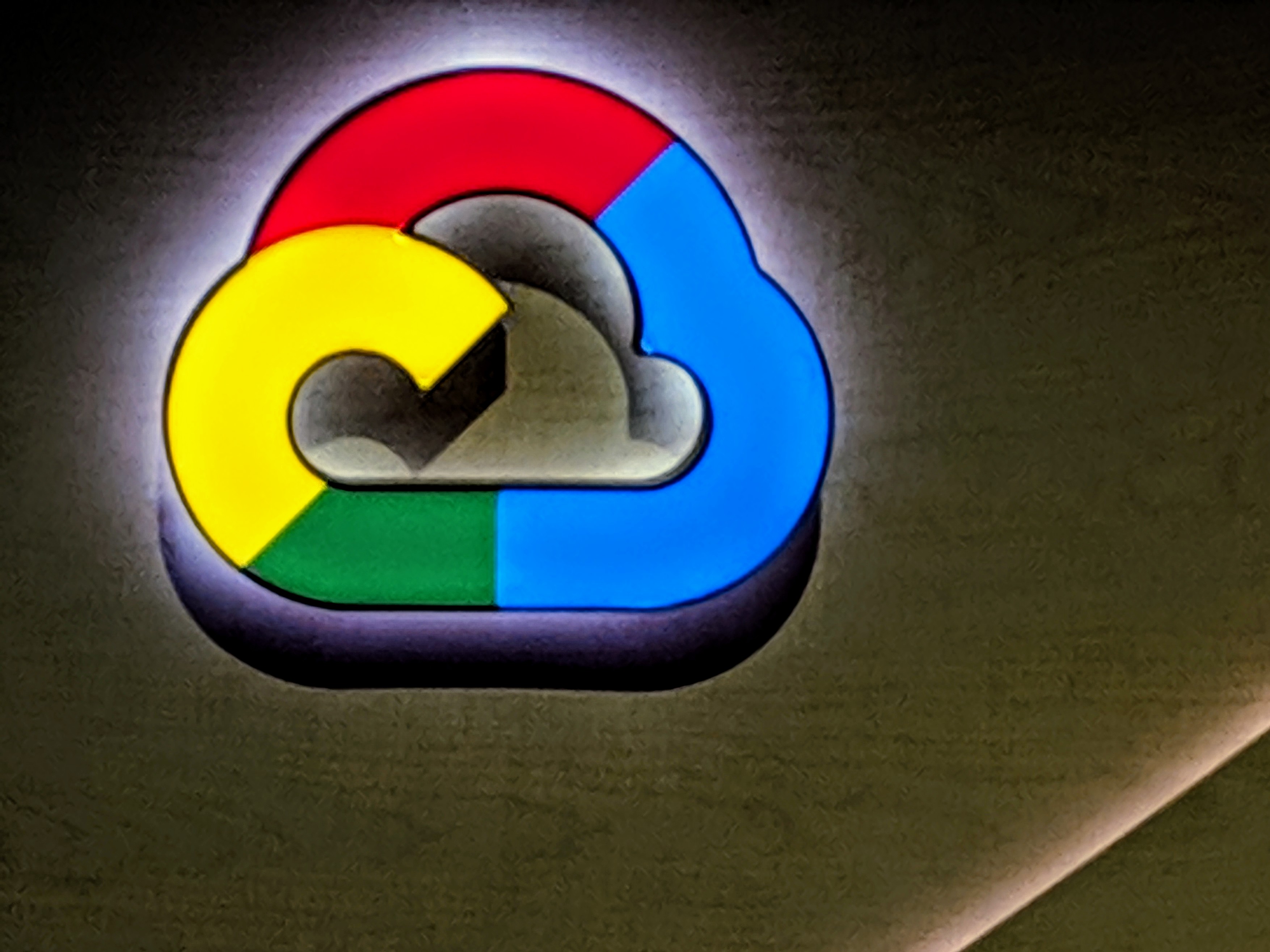 Enterprises want Google to figure out the enterprise, Kurian argues, because they want to use the company’s technology. “And so we’re trying to do that.”
Enterprises want Google to figure out the enterprise, Kurian argues, because they want to use the company’s technology. “And so we’re trying to do that.”
No matter what he thinks about Diane Greene’s tenure at Google Cloud, though, Kurian undoubtedly has the opportunity to reshape the organization now. When I asked him about how his own philosophy is different from his predecessor, though, he argued that it’s all about listening to customers and giving them what they want. And what they want is more help, but also better collaboration tools, for example, as well as more industry-specific solutions.
Later on, though, he also noted that what Google Cloud will do going forward is to play to its strengths. “I think you will see us emphasizing our differentiators and strengthening the multi-cloud infrastructure,” he said, and highlighted today’s launch of Anthos as an example of what the company can do — and as a product that was developed in response to customer requests. “We’ve taken the area of security. We’ve taken the area of analytics. We’ve taken the area of AI — and we’ve invested a lot more in solutions there. And the reason is, that’s what customers want from us,” he added
It’s no secret that Google is definitely focusing on bringing more enterprises onto its platform. That’s not to say that Google Cloud doesn’t care about startups, though. “When we say we’re focused on enterprise, it doesn’t mean we’re stopping to focus on the small and medium companies — on the digital natives and the startups,” Kurian said. “Historically, the complaint has always been ‘Google doesn’t focus on enterprises, they focus on digital natives. […] The perception outside that Google doesn’t care about enterprises is not true. And the statement that we’re now going to focus exclusively on enterprises is also not true.”
Kurian argues that nine of the 10 largest media companies use Google Cloud, as well as seven of the 10 largest retailers and six of the top 10 enterprise companies. “Other cloud providers would have you believe that no one is using Google, which is not true,” he added.
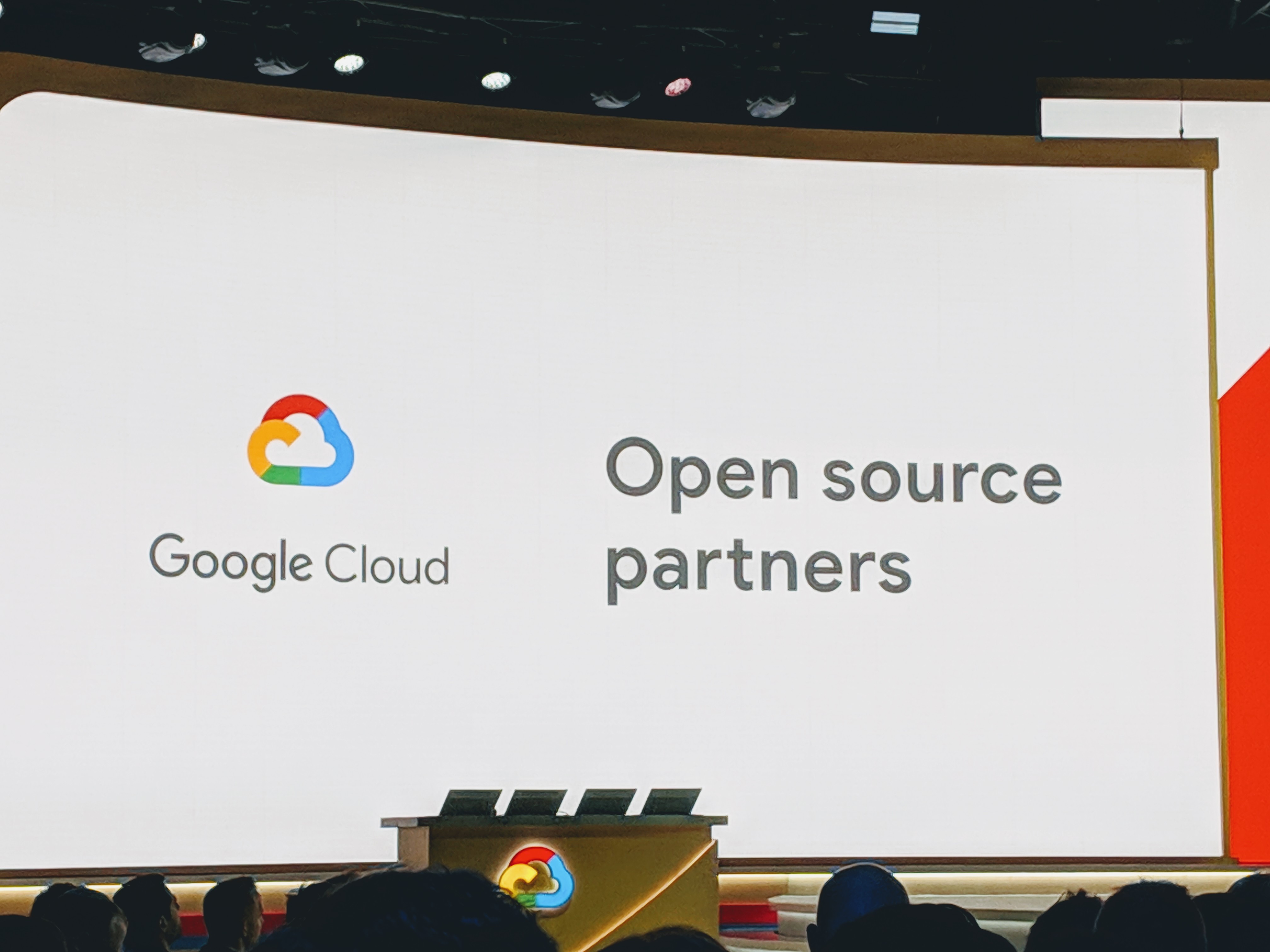
Talking about other cloud providers, it’s also worth noting that Google is taking a very different approach to open source than some of its competitors, and especially AWS. That’s something that isn’t likely to change under Kurian’s leadership at Google Cloud. “The most important thing is that we believe that the platforms that win in the end are those that enable rather than destroy ecosystems. We really fundamentally believe that,” he told me. “Any platform that wins in the end is always about fostering rather than shutting down an ecosystem. If you look at open-source companies, we think they work hard to build technology and enable developers to use it.”
Kurian isn’t the kind of CEO who will directly attack his competitors in an interview, but he did come rather close to it in this context: “In order to sustain the company behind the open-source technology, they need a monetization vehicle. If the cloud provider attacks them and takes that away, then they are not viable and it deteriorates the open-source community.”
As for the future of Google Cloud, Kurian didn’t quite want to look at his crystal ball. Instead, he argued that as long as the company focuses on doing what its customers want — starting with hiring more employees to help those customers and making it easier to do business with Google — those customers will buy a lot more of their cloud technology from Google.
Powered by WPeMatico
